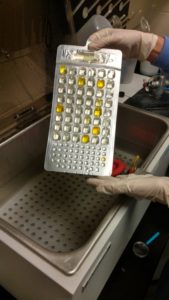Disinfection and Testing — the Final Steps in Wastewater Treatment
October 18, 2019Over the past several months, we’ve talked about why wastewater must be treated, and detailed each step in the treatment process at Allentown’s Kline’s Island Wastewater Treatment Plant.
Now we’ve come to the final treatment step: disinfection, in which we use a chlorine solution to kill pathogenic (disease-causing) microorganisms before the wastewater is released into the Lehigh River.
As we mentioned in our previous post about Tertiary Nitrification, overflow from the Final Settling Tanks flows into a Chlorine Contact Tank, or CCT — that’s what you see in the main picture above. Chlorine is fed to injectors located in our Chlorination Building and combined with reused plant effluent to form a chlorine solution. Then a diffuser evenly applies this solution in the CCT.
The CCT is divided into two sections that can be isolated for cleaning. Inside, serpentine channels provide enough contact time to allow the chlorine solution to kill off pathogenic microorganisms in the wastewater.
Then, just before entering the Lehigh River, the now fully treated wastewater flows through a device called a Parshall Flume, which measures flow so that we can determine the proper chlorine dosage in the previous step. The turbulence caused by the flume also helps to add dissolved oxygen, which is important for a healthy aquatic ecosystem.
Keep in mind that disinfection is not the same as sterilization, which is an extreme physical and/or chemical process that kills all types of life. In wastewater treatment, disinfection is aimed at eliminating only the disease-causing microorganisms contained in human waste.
Although the wastewater treatment process removes the majority of contaminants, plant effluent is not potable. The goal is to release water that meets all federal and state requirements, and is fishable and swimmable. While releasing potable water would be ideal, it’s simply not cost-effective at most wastewater treatment plants around the world — the capital investment and operating costs would be astronomical. Dilution, which occurs when treated water is released into streams and oceans, and treatment at drinking-water plants must do the rest.

At Kline’s Island, our laboratory conducts comprehensive testing and cross-testing to ensure the wastewater meets and exceeds standards set by the Environmental Protection Agency. This includes daily and quarterly tests for a number of conditions and contaminants, including: pH level, ammonia, nitrogen, fecal coliform bacteria, organic and inorganic compounds, and more. The test results are sent monthly to the state’s Department of Environmental Protection and the federal EPA.
What can you do to help? Never flush medications or chemicals other than ordinary household cleaners down the drain.
Stay tuned for a post about our Industrial Waste Treatment process. And for the rest in our Behind the Scenes series, please see:
Wastewater Treatment Starts with Screening Out Items That Don’t Belong
Why Does Wastewater Need to be Treated?
Pump it Up: The Role of LCA’s Giant Wastewater Movers
Clean and Green: How Waste is Turned into Energy at Kline’s Island
Sludge 101: How Solids Are Removed From Wastewater
The Sludge Report: What Happens After Treatment?
How Is Liquid Waste Treated? It’s All About Biology
Tertiary Nitrification: How Ammonia Is Removed From Wastewater